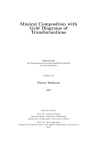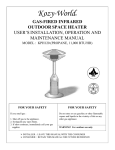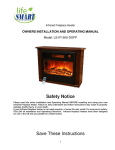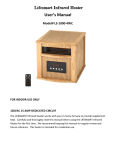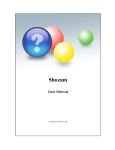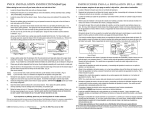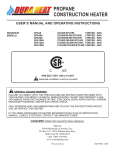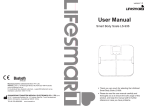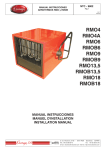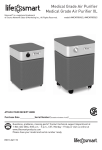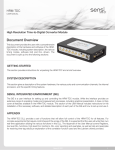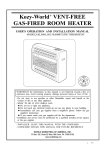Download An Investigation onOptimal Personal Heaters
Transcript
UBC Social Ecological Economic Development Studies (SEEDS) Student Report An Investigation on Optimal Personal Heaters Amar Manj, Dong Lin Xuan, William Geng, Ziqian Wang University of British Columbia APSC 262 April 09, 2015 1071 1796 Disclaimer: “UBC SEEDS Program provides students with the opportunity to share the findings of their studies, as well as their opinions, conclusions and recommendations with the UBC community. The reader should bear in mind that this is a student project/report and is not an official document of UBC. Furthermore readers should bear in mind that these reports may not reflect the current status of activities at UBC. We urge you to contact the research persons mentioned in a report or a SEEDS team representative about the current status of the subject matter of a project/report”. The University of British Columbia APSC 262 - Technology and Society II Tutorial Instructor: Dr. Naoko Ellis An Investigation on Optimal Personal Heaters Submitted by: William Geng Amar Manj Ziqian Wang Dong Lin Xuan April 9, 2015 i ABSTRACT This report provides an in-depth analysis on the selection of an optimal office space heater to serve as a replacement for the current 1500W convection heaters that are used by the UBC staff. Available models currently on the market are investigated using the triple bottom line analysis. The methods of investigation for this project consisted of gathering both primary and secondary data. Primary data consists of only user reports and company datasheets. Secondary sources include peer-reviewed journal articles and online articles. Within the economic aspect of the triple bottom line, the purchase cost, payback period and energy cost savings were evaluated with the assumption that the heater was used for a fixed number of hours per year. This analysis determined that the Lifesmart/LS-IQH-DMICRO-IN is the best economical choice. The environmental aspect compared energy savings and greenhouse gas emissions during the manufacturing process. For the social aspect, user experience and safety are taking into consideration along with manufacturer background. The final recommendation for UBC is to only offer the Lifesmart/LSIQH-DMICRO-IN heater to staff members requiring additional heat during the winter. ii Table of Contents ABSTRACT ....................................................................................................................................................................... i List of Equations ........................................................................................................................................................... iv List of Figures ................................................................................................................................................................ iv List of Tables ................................................................................................................................................................. iv GLOSSARY ...................................................................................................................................................................... v LIST OF ABBREVIATIONS ............................................................................................................................................... vi 1.0 INTRODUCTION........................................................................................................................................................1 2.0 METHODS OF INVESTIGATION .................................................................................................................................2 2.1 PRIMARY SOURCES ..............................................................................................................................................2 2.2 SECONDARY SOURCES .........................................................................................................................................2 3.0 COMPARISON OF DIFFERENT TYPES OF HEATERS ...................................................................................................3 3.1 FAN-FORCED HEATERS .........................................................................................................................................3 3.1.1 BACKGROUND...............................................................................................................................................3 3.1.2 ADVANTAGES AND DISADVANTAGES ...........................................................................................................4 3.2 OIL-FILLED HEATER ..............................................................................................................................................4 3.2.1 BACKGROUND...............................................................................................................................................4 3.2.2 ADVANTAGES AND DISADVANTAGES ...........................................................................................................5 3.3 CERAMIC HEATER ................................................................................................................................................5 3.3.1 BACKGROUND...............................................................................................................................................6 3.3.2 ADVANTAGES AND DISADVANTAGES ...........................................................................................................6 3.4 INFRARED HEATER ...............................................................................................................................................7 3.4.1 BACKGROUND...............................................................................................................................................7 3.4.2 ADVANTAGES AND DISADVANTAGES ...........................................................................................................7 3.5 CONCLUSION OF THE COMPARISONS .................................................................................................................8 4.0 TBL ASSESSMENT OF INFRARED HEATER MODELS ..................................................................................................8 4.1 ECONOMIC ASPECTS ............................................................................................................................................9 4.1.1 Product Price: ...............................................................................................................................................9 4.1.2 Electricity Savings .......................................................................................................................................10 4.1.2 Payback Period ...........................................................................................................................................11 4.2 ENVIRONMENTAL ASPECTS ...............................................................................................................................12 4.2.1 Carbon Emission .........................................................................................................................................12 4.2.2 Energy Efficiency Settings and Controllability ............................................................................................12 4.3 SOCIAL ASPECTS.................................................................................................................................................13 iii 4.3.1 Manufacturer Background ..........................................................................................................................13 4.3.2 Safety ..........................................................................................................................................................14 4.3.3 Comfort-Related Features ..........................................................................................................................15 5.0 CONCLUSION AND RECOMMENDATIONS .............................................................................................................16 References ...................................................................................................................................................................18 iv List of Equations Equation 1: Calculating Electricity Cost per Year .........................................................................................................10 List of Figures Figure 1: Typical Fan Forced Heater ..............................................................................................................................3 Figure 2: TYPICAL Oil-Filled HEATER ..............................................................................................................................5 Figure 3: A Typical Portable Ceramic Heater .................................................................................................................6 Figure 4: Portable Infrared Heater ................................................................................................................................7 Figure 5: LifeSmart New Infrared Technology .............................................................................................................15 List of Tables Table 1: Purchase cost of selected models ....................................................................................................................9 Table 2: Power of selected models ..............................................................................................................................10 Table 3: Electricity Savings Comparison between chosen Models and the Standard 1500W Personal Heater ..........11 Table 4: Payback Period of Selected Models ...............................................................................................................11 Table 5: Energy Efficiency Settings and Controllability Features of Selected Models .................................................13 Table 6: Safety Feature of Chosen Models ..................................................................................................................14 Table 7: Additional Comfort Related Feature of Four Models ....................................................................................15 Table 8: Summary of Triple Bottom Line Assessment .................................................................................................16 v GLOSSARY Ventilator a device that blows fresh air into the room and expels dirty air Payback Period the period of time required to recover the cost of an investment. vi LIST OF ABBREVIATIONS TBL Triple Bottom Line HVAC Heating, ventilating, and air conditioning 1 1.0 INTRODUCTION During the long cold winter months in Vancouver, faculty and staff of UBC rely on the old HVAC systems to keep them warm and cozy throughout the day. The HVAC system, however, is inefficient as many staff members have purchased their own personal heaters for their offices. As more space heaters are purchased and used, there is a great increase in the energy demand. Assuming that the staff members utilize a standard 1500W air convection heater, there would be a large burden on UBC’s power consumption. Even though such a model could be cheaper and provide an adequate level of comfort, it would be wasteful. Each 1500W air convection heater could take up to 1% of the building’s power when in full cycle, and the heated air could still escape through opened office doors or any other free air-flowing area. This “escaped” heat confuses the temperature sensor of the HVAC system -- triggering unnecessary cooling during the winter time. To address the issue, UBC SEEDS is working to create a trade-in program for employees in which they could trade-in their old heaters for a more sustainable heater for free. The purchase cost as well as the trade-in cost would be recouped from later electricity cost savings. This report explores the four major types of heaters available on the market: Fan-Forced air convection heater, Ceramic heaters, Oil-filled heaters, and Infrared radiant heaters. By evaluating the advantages and disadvantages of each type of heater, an optimal heater type is selected to replace the standard air convection heaters. Based on the type of heater selected, different models of the chosen type are compared and contrasted using the triple bottom line assessment. 2 2.0 METHODS OF INVESTIGATION As shown in the subsections below, the investigation began with an extensive literary review of primary and secondary sources. A general consensus is achieved upon analyzing the collected data, thus revealing the generic features of each of the space heater models. 2.1 PRIMARY SOURCES Primary sources include consumer reports and customer reviews found on popular retail store websites such as Best Buy and Home Depot. These reports not only detail the functionalities of specific heater models but also reveal their defects. Also, by analyzing the consumers’ review on the space heater, a list of social, environmental, and economic aspects are compiled. The main aspects found in consumer reviews were then utilized as indicated for the TBL assessment. For example, factors such as comfort and safety are evaluated under social indicators. Other factors such as purchase cost and expected lifespace are used as economic indicators. 2.2 SECONDARY SOURCES The secondary sources consulted include product specifications, user manuals on websites, peer-reviewed academic journal articles about personal space heaters, and previous TBL assessment reports relevant to this project. The reason for choosing similar (past) TBL reports is because they provide a broad idea about how the project objective can be achieved, and what part of the project can be better conducted. Moreover, quantitative reviews of peerreviewed academic journal articles provide indispensable background information and knowledge of this project. 3 3.0 COMPARISON OF DIFFERENT TYPES OF HEATERS The space heaters can be divided into two broad categories: Gas heaters and Electric heaters. Since the heaters are to be used in UBC workspaces, safety, portability and ease of use are major aspects of consideration. Gas heaters are hard to install and using gas can be dangerous due to the risk of fire and gas leaks. As a result the investigation is focused on the four popular types of electric heaters: Fan-forced air convection heaters, Oil-filled heaters, Ceramic heaters, and Infrared Radiant heaters. 3.1 FAN-FORCED HEATERS Fan-forced heaters (Figure 1) are a popular type of heater with a price range from $10 to $600 (Home Depot, 2015). It is widely used in the home places. 3.1.1 BACKGROUND Fan-forced heaters are heated by passing electric current through the coil elements, thus heating the coils inside the heater. A built-in ventilator blows the air through the heated coils while heating the air in the process. F IGURE 1: TYPICAL FAN F ORCED H EATER Source: http://www.worldmkting.com/sites/default/files/HB211T.jpg 4 This process then forces the hot air to circulate the room, thus raising the temperature in the room. 3.1.2 ADVANTAGES AND DISADVANTAGES Fan forced heaters are relatively cheap to purchase since the design is extremely simple. The use of ventilator not only speeds up the heating process but also evenly distributes the heat throughout the room. As the fan operates, an audible noise is generated which would be disruptive for users requiring a quiet workspace. The heated air reduces the humidity of the office creating a dry environment for the user. Moreover, the heated air tends to escape the room from window leakages and opened doors, further extending the “On” cycles and wasting energy. 3.2 OIL-FILLED HEATER The price range of the Oil-filled heater (see Figure 2) varies greatly: $30 to $300 (Home Depot, 2015) 3.2.1 BACKGROUND The Oil-filled heater consists of metal columns with cavities. It contains oil acting as a heat reservoir which circulates the heater and heats up the fins of the heater. 5 F IGURE 2: TYPICAL O IL -FILLED HEATER Source: http://www.homedepot.ca/wcsstore/HomeDepotCanada/images/catalog/17124.CYAA45-7T 4.jpg The surface of these fins is in contact with air and thus heats up the room through the process of convection. 3.2.2 ADVANTAGES AND DISADVANTAGES Oil-filled heaters uses natural air circulation to heat the room (heated air rises while cooler, more dense air sinks to be heated by the metal columns), and operates silently. The natural circulation, however, results in a much slower temperature increase when turned on. This effect is not desirable especially when staff members arrive in the morning while the office is very cold. Similar to the Fanforced heaters, the heated air will escape the room through opened doors and window leakages, hence reducing its effectiveness in heating. 3.3 CERAMIC HEATER The Ceramic heater’s (Figure 3) price ranges from $15 to $250 (Home Depot, 2015) 6 3.3.1 BACKGROUND The working principle of the ceramic heater is similar to the fan-forced heater. F IGURE 3: A TYPICAL P ORTABLE C ERAMIC HEATER Source: http://www.veotag.com/images/delonghidch1030safeheat-1.jpg It generates heat by passing electric current through the electrically heated ceramic and aluminum plates, while relying on a blower fan to distribute heat. 3.3.2 ADVANTAGES AND DISADVANTAGES Ceramic heater has the lowest price among the electric heaters. Fans and thermostats inside the heater prevent it from overheating. Moreover, many ceramic heaters have the oscillating feature which allows them to heat the room faster and more effectively. The ceramic heater does, however, operate loudly and produces dry heat. Dust could potentially accumulate on the ceramic plates while the heater is not in-use and be blown into the air when turned on. This would pose as a safety concern, if not hazard, to people with respiratory problems and allergies. 7 3.4 INFRARED HEATER The price range of the infrared heater varies between $25 to $600 (Home Depot, 2015). 3.4.1 BACKGROUND Infrared heaters, as seen in Figure 4, use a built-in infrared lamp to emit invisible infrared light at an adjustable intensity. This light increases the temperature of the object it makes contact with, without heating the air. F IGURE 4: P ORTABLE I NFRARED H EATER Source: http://www.o-digital.com/uploads/2179/2196-3/Infrared Heater IH a 115.jpg 3.4.2 ADVANTAGES AND DISADVANTAGES Similar to the sunlight’s warmth, the infrared heater operates without heating the air and provides comfortable heat to the user. It is energy efficient since it only heats objects covered by the infrared light. In addition, it operates silently and requires minimal maintenance. Since the infrared heater’s surface operates at a high temperature, it carries a potential burn hazard. Additionally, turning the power off causes the 8 heat to turn off immediately. Another flaw for this heater is that it heats in certain directions, and therefore, limits the user’s movement around the room. 3.5 CONCLUSION OF THE COMPARISONS The four types of heaters, each have their own advantages and disadvantages. Ceramic heater and Fan-forced heater are relatively cheaper and they heat the room fast and evenly. Unfortunately, they both operate with an audible noise, reduce air humidity, and blow dust and other allergens into the air. The oil-filled heater is relatively safer, but it heats slowly and is hard to maintain a consistent, desirable temperature. The infrared heater is preferred because of its silent and comfortable heat. Additionally, it will not trigger HVAC cooling as the air in the office would not be directly heated. The general temperature of the building will still be controlled by the HVAC system while infrared heaters can provide additional heat directly to the user as needed. Since there are not many children or pets around the office areas, the burning hazard of accidentally touching the inner components of the heaters can be viewed as a small risk. Based on the advantages and disadvantages listed for each type of heater, it is safe to recommend Infrared heater. The UBC SEEDS project coordinator explained that social aspects are to be considered, before environmental, and finally economic. Therefore, as the conclusion of this section, infrared heater is selected as a favorable type of heater for use in the UBC workspaces. 4.0 TBL ASSESSMENT OF INFRARED HEATER MODELS In the previous section, we concluded that the infrared heater is the recommended heater type. In order to recommend a specific heater model, different infrared heaters are compared in economic, environmental, and social aspects. As mentioned previously, priority is given to social aspects first, then environmental, and finally economic. The four heater models are from Home Depot, each with a limiting heated area between 0 to 400 sq.ft and a consumer rating above three stars. These factors were used to apply the TBL assessment. 9 The following models were chosen and analyzed using the triple bottom line assessment: 1. Optimus H-4438 14 in. Oscillating Radiant Dish Heater with Remote Control H4438 2. 250-Watt to 500-Watt Electric Parabolic Heater with Oscillation JHS500G 3. Optimus 22 in 500 Watt 1000 Watt Oscillating Carbon Barrel Heater with Remote Control H84001 4. Life Pro Series 400-Watt Plug-in Micro Infrared Heater with Digital Display LS-IQH-DMICRO-IN 4.1 ECONOMIC ASPECTS The four infrared heater models are evaluated with respect to their economic aspects. The product price, payback period and electricity savings are chosen as indicators. 4.1.1 Product Price: The prices of the selected models can be seen in Table 1. Note that UBC plans on purchasing 750 units for the staff members. T ABLE 1: C OST OF SELECTED M ODELS Model No. Product Price(CAD) Optimus/H4438 $64.97 Unbranded/JHS500G $24.99 Optimus/H84001 $69.97 Lifesmart/LS-IQH-DMICRO-IN $39.97 10 As the data shown on the table, the unit price of our models ranges from $24.99 to $69.97, which is an affordable range for UBC. 4.1.2 Electricity Savings The electricity savings is a direct index showing how much a recommended heater saves in the economic aspect. To calculate the electricity savings (per year), simply multiply the power of a heater by its time of use, and then analyze the difference with the electricity cost of a standard 1500W space heater. Table 2 shows the four infrared models and the corresponding power produced. T ABLE 2: P OWER OF SELECTED MODELS Model# Power(Watt) Optimus/H4438 800 Unbranded/JHS500G 250 Optimus/H84001 1000 Lifesmart/LS-IQH-DMICRO-IN 400 According to the stakeholder, the heater is assumed to run for 5 hours a day for every five days a week. This is expected to continue for a total of 20 weeks. The electricity rate on UBC campus is estimated at $0.0539/kWh. E QUATION 1: CALCULATING E LECTRICITY COST PER YEAR 𝑐𝑜𝑠𝑡/𝑦𝑟 = 𝑝𝑜𝑤𝑒𝑟 × ℎ𝑜𝑢𝑟𝑠/𝑑𝑎𝑦 × 𝑑𝑎𝑦𝑠/𝑤𝑒𝑒𝑘 × 𝑤𝑒𝑒𝑘𝑠/𝑦𝑒𝑎𝑟 × 𝑒𝑙𝑒𝑐𝑡𝑟𝑖𝑐𝑖𝑡𝑦 𝑟𝑎𝑡𝑒 Using the aforementioned formula (Equation 1), the electricity cost per year of each of the infrared heaters is calculated and compared with the 1500W Convection Heater to determine the yearly electricity savings (as shown in Table 3) for each model. 11 T ABLE 3: ELECTRICITY SAVINGS C OMPARISON BETWEEN CHOSEN M ODELS AND THE STANDARD 1500W PERSONAL HEATER Model # Electricity Savings(CAD/yr) Optimus/H4438 $18.87/year Unbranded/JHS500G $33.69/year Optimus/H84001 $13.48/year Lifesmart/LS-IQH-DMICRO-IN $29.65/year Note that the above numbers are representative of a single unit and that the stakeholder plans on purchasing 750 units of space heaters. 4.1.2 Payback Period For further analysis on the economic aspects, comparisons were made with the payback period of the chosen models, to indicate the length of time required for the investment to recover its initial outlay in terms of profits or savings. To calculate the payback period, simply divide the product price of a specific model by its calculated savings per year compared to a standard 1500W personal heater. The resultant payback period of each model can be found in Table 4. T ABLE 4: PAYBACK P ERIOD OF SELECTED MODELS Model# Payback Period (years) Optimus/H4438 3.44 Unbranded/JHS500G 0.74 Optimus/H84001 5.19 Lifesmart/LS-IQH-DMICRO-IN 1.35 12 4.2 ENVIRONMENTAL ASPECTS Although prioritized second, the environment plays a big role when evaluating the triple bottom line assessment. The manufacturing companies are often neglected when examining the impact on the environment. Another important indicator for the environmental aspects includes the energy efficiency. 4.2.1 Carbon Emission To analyze the carbon emission of a specific product, generally, the emission during manufacturing and using process should be considered. The carbon emission during the manufacturing process is hard to be determined because there is no relative data found on the supplier’s website or even on the manufacturers’ webpage. Since all the chosen models are infrared heaters that consume electricity, only the carbon emissions produced during the production of electricity need to be considered. For example, greenhouse gasses are released during the combustion of fossil fuels, such as coal, oil and natural gas, to produce electricity. Under this condition, the amount of carbon emission during the using process is in direct proportion to a infrared heater’s power, meaning that low power heaters are a product of less carbon emissions. Therefore, in order to reduce the carbon emission of heating, a lower powered heater should be chosen. 4.2.2 Energy Efficiency Settings and Controllability As shown in the Table 5, the selected models all have energy efficient settings allowing the user to choose between the different heating levels. Also, the last model is noteworthy because it has a built-in thermostat control which can be preset with a desired temperature to automatically power the unit on and off by detecting the room temperature. 13 T ABLE 5: ENERGY EFFICIENCY S ETTINGS AND C ONTROLLABILITY FEATURES OF SELECTED MODELS Model# Energy Efficiency Settings and Controllability Optimus/H4438 ❖ 2 heat settings: 800 and 1200Watt ❖ Remote control Unbranded/JHS500G ❖ 2 heat settings: 250 and 500-Watt ❖ Remote control Optimus/H84001 ❖ Adjustable settings ❖ Timer Lifesmart/LS-IQH-DMICRO-IN ❖ Digital thermostat control ❖ Timer 4.3 SOCIAL ASPECTS The stakeholder for this project emphasized the importance of the social aspects. As mentioned in the previous sections, the key indicators for social aspects includes topics such as safety and the overall comfort of the user. 4.3.1 Manufacturer Background LifeSmart Corporation is a newly founded tech company, formerly Source Network Sales and Marketing that brings new infrared heating products featuring luxury, state-of-the-art designs and much-needed safety enhancements, all of which received critical acclaim and recognition at the 2014 International Home + Housewares Show in Chicago, Illinois. This Chinese based company develops smart home solutions that are environmentally friendly and also easy to afford (Factiva, 2015). As the company is relative new to the industry very few third party reviews have been found throughout the internet. Our investigation includes a 30 minute phone interview with the customer service representative and gathered 14 information on employee welfare and environmental precautions during production. At LifeSmart the company is fully in compliance with the Chinese Labour Law. Employees are ensured with fair pay, regular working hours and holidays. Assembling factories are located in Shenzhen, Guangzhou and Shanghai with necessary components shipped in from mostly local suppliers. The manufacturing process of the heaters are half automated and half manual. Little carbon emission is present during the production apart from generating electricity at local power plants as source of power for automated production lines. The manual production line generates no carbon emission. The company provides heater products that are both economically and environmentally friendly for users around the globe. 4.3.2 Safety As shown in Table 6, all of our selected models have special features to help improve user safety. Note that the fourth model, Lifesmart, is the only one with the ETL listed mark, which is proof that the product is compliant with North American safety standards. T ABLE 6: SAFETY FEATURE OF C HOSEN M ODELS Model # Safety Features Optimus/H4438 ❖ Safety tip over switch ❖ Overload thermal protector Unbranded/JHS500G ❖ Safety tip over switch Optimus/H84001 ❖ Safety tip over switch Lifesmart/LS-IQH-DMICRO-IN ❖ Over heat safety switch ❖ ETL listed 15 4.3.3 Comfort-Related Features The four infrared models each have special comfort-related features which have been listed below in Table 7. T ABLE 7: ADDITIONAL COMFORT RELATED FEATURE OF F OUR MODELS Model # Additional Features Optimus/H4438 ❖ 75˚ oscillation Unbranded/JHS500G ❖ Wide angle oscillation Optimus/H84001 ❖ Ultra quiet operation ❖ Timer Lifesmart/LS-IQH-DMICRO-IN ❖ Digital thermostat control ❖ Timer The oscillation function of the first two models make the heater more efficient. The last two models use timers which makes the heater easier to use. Additionally, the Optimus H84001 contains an “ultra quiet operation” functionality allowing its users to work without being disturbed. F IGURE 5: LIFE SMART NEW INFRARED TECHNOLOGY Source: http://i.ytimg.com/vi/0nyuFtxf0hc/maxresdefault.jpg 16 The Lifesmart heaters contains a digital thermostat which allows the user to set a desired temperature while the built-in thermostat powers the heater on and off by detecting room temperature. Lifesmart also features Wrapped Infrared Quartz Element (see Figure 5) to provide efficient and natural warmth. 5.0 CONCLUSION AND RECOMMENDATIONS As the triple bottom line assessment applied in the previous section, the four infrared heater models were analyzed in all three, economic, environmental and social aspects. The triple bottom line assessment of the four heaters is summarized in Table 8. T ABLE 8: SUMMARY OF TRIPLE BOTTOM L INE ASSESSMENT As shown on the table, the last two heaters, Optimus/H84001 and Lifesmart, have a greater advantage in the economical aspect. Considering that social aspects such as safety and comfort are more important, recommendation is given to the last model, Lifesmart LS-IQH-DMICRO-IN Infrared Heater. Its digital 17 thermostat control function provides the users with a major convenience. Additionally, it’s ETL listed mark makes it more reliable in terms of safety. The Lifesmart Life Pro Series Micro Heater provides infrared warmth in small areas. Users can simply plug the unit into the wall and set the digital thermostat for gentle warming infrared heat. This heater is ideal for small spaces like under a desk, small dorm room, laundry room or bathroom. The built in thermostat control automatically powers the unit on and off. This micro heater also includes a timer feature as well for ease of operation. 18 References Ali, A. H., H., & Gaber Morsy, M. (2010). Energy efficiency and indoor thermal perception: A comparative study between radiant panel and portable convective heaters. Energy Efficiency, 3(4), 283-301. http://dx.doi.org/10.1007/s12053-010-9077-3 BC Hydro. (n.d.). What you need to know about portable electric space heaters. BC Hydro. Retrieved from: http://www.bchydro.com/content/dam/hydro/medialib/internet/documents/Power_Smart_FACT_sheets /Portable_Electric_Space_Heaters.pdf Factiva. (2015, March 31). LifeSmart; LifeSmart, New Choice to Automate Your Home. Retrieved from https://global-factiva-com.ezproxy.library.ubc.ca/ga/default.aspx HomeDepot(2015) H4438 Product Information. Retrieved From: http://www.homedepot.com/p/Optimus-14-inOscillating-Pedestal-Digital-Dish-Heater-with-Remote-ControlH4438/205495061?N=5yc1vZc8oeZ2bctm5Z2bctm6Z2bcu02Z2bcu04Z2bcu05 HomeDepot(2015) JHS500G Product Information. Retrieved From:http://www.homedepot.com/p/Unbranded250-Watt-to-500-Watt-Electric-Parabolic-Heater-with-OscillationJHS500G/205743593?N=5yc1vZc8oeZ2bctm5Z2bctm6Z2bcu02Z2bcu04Z2bcu05 HomeDepot(2015) H84001 Product Information. Retrieved From:http://www.homedepot.com/p/Optimus-500Watt-1000-Watt-22-in-Oscillating-Carbon-Barrel-Heater-with-Remote-ControlH84001/205433937?N=5yc1vZc8oeZ2bctm5Z2bctm6Z2bcu02Z2bcu04Z2bcu05 HomeDepot(2015) LS-IQH-DMICRO-IN Product Information. Retrieved From:http://www.homedepot.com/p/Lifesmart-Life-Pro-Series-400-Watt-Plug-in-Micro-Infrared-Heaterwith-Digital-Display-LS-IQH-DMICROIN/205422939?N=5yc1vZc8oeZ2bctm5Z2bctm6Z2bcu02Z2bcu04Z2bcu05 Previous Seeds Project LifeSmart Corp. (2015, March 15). Infrared Quartz Heater User Manual. Retrieved from http://lifesmartproducts.com/wp-content/uploads/2014/06/LS-IQH-DMICRO-OM-Rev1-052914.pdf Marina Oster, ( 2010, March) Space Heaters vs. Central Heating: Essential Question Retrieved from: https://alumni.stanford.edu/get/page/magazine/article/?article_id=29533 Will, Henry, (2015, January 6) Which is the Most Energy Efficient Space Heater? 6 Reviews & Some Tips Retrieved from: http://gadgetboy.hubpages.com/hub/Which-is-the-Most-Energy-Efficient-Space-Heater-5-ReviewsSome-Tips Williams, K. (2004). Selecting space heaters. Plant Engineering, 58(4), 52-54. Retrieved from http://search.proquest.com.ezproxy.library.ubc.ca/docview/221012713?accountid=14656


























